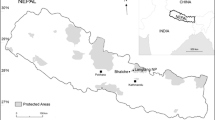Abstract
In Nigeria, deforestation, which leads to tremendous loss of biodiversity, is well advanced and about 90% of its rain forest has already been cleared. The Nigerian environment is also beset with many other problems including a food crisis. To address these problems a research project on “Development and Utilization of some endangered edible forest species of South-eastern Nigeria” was sponsored by World Wildlife Fund, Washington D.C. The Project investigated chemical evaluation, formulation of new edible products and ex-situ conservation techniques of 16 study species and produced significant results in each of these aspects.
Résumé
Au Nigeria, la déforestation, qui entraîne une énorme perte de la biodiversité, est fort avancée et environ 90 % de la forêt ombrophile a déjà été défrichée. L’environnement du Nigeria est aussi confronté à de nombreux autres problèmes, notamment à la crise alimentaire. Pour aborder ces problèmes, un projet de recherche sur “Le développement et l’utilisation des espèces forestières comestibles dans le sud-est du Nigeria” a été subsidié par le “World Wildlife Fund” de Washington D.C. Ce projet a permis de procéder à une évaluation chimique, de détecter de nouveaux produits comestibles et d’établir des techniques de conservation ex-situ pour 16 espèces étudiées; des résultats significatifs ont été obtenus pour chacun de ces aspects de recherche.
Access this chapter
Tax calculation will be finalised at checkout
Purchases are for personal use only
Preview
Unable to display preview. Download preview PDF.
Similar content being viewed by others
References
Agboola, S.A., 1979. An Agricultural Atlas of Nigeria. Oxford University Press, Oxford.
Ajayi, G.A., 1986. Production of composite seasoning from local species. Higher National Diploma Research Project. Dept. of Food Technology, Idah, Benue State, Nigeria.
Anazonwu-Bello, J.N., 1981 Indigenous foods and nutritional adequacy. Symposium on development of indigenous technology. Ministry of Science and Technology, Enugu, Nigeria.
Ejiofor M.A.N., S.N. Onwubuke & J.C. Okafor, 1987. Developing improved methods of processing and utilization of kernels of Irvingia gabonensis (var. gabonensis and var. excelsa). Int. Tree Crops 4 (4): 283–290.
Ejiofor, M.A.N., O.R. Obiajulu & J.C. Okafor, 1988. Diversifying utilities of African breadfruit (Treculia africana Decne. subsp. africana) as food and feed. Int. Tree Crops 5 (3): 125–134.
Iwu, M.M., O.A. Igboko, U.A. Onwuchekwa & C.O. Okonji, 1987. Evaluation of the antihepatotoxic activity of the biflavonoids of Garcinia kola seeds. Ethnopharmacol. 21: 127–138.
Keay, R.W.J., 1959. An Outline of Nigerian Vegetation. Federal Department of Forestry Research, Federal Ministry of Information, Lagos.
Myers, N., 1989. Deforestation Rates in Tropical Forests and their Climatic Implications. Friends of the Earth, London.
NEST, 1991. Nigeria’s Threatened Environment. A National Profile. Nigerian Environmental Study Action Team ( NEST ), Ibadan.
Okafor, J.C., 1978. Development of forest tree crops for food supplies in Nigeria. Forest Ecol. Management 1: 235–247.
Okafor, J.C., 1980. Edible indigenous woody plants in the rural economy of the Nigerian forest zone. Forest Ecol. Management 3.
Okafor, J.C., 1981. Woody plants of nutritional importance in traditional farming systems of the Nigerian humid tropics. Ph.D. thesis. University of Ibadan, Ibadan, Nigeria.
Okafor, J.C., 1982. Promising trees for agroforestry in Southern Nigeria. United Nations University Publication, Tokyo, Japan, pp 103–107.
Okafor, J.C., 1989. Agroforestry aspects. Appendix 2 in: Caldecott et al. 1987. Cross River National Park. Oban Division: Plan for developing the park and its support zone. WWF, Godalming, UK.
Okafor, J.C., 1990a. Agroforestry development in the Boshi-Okwangwo Division of the Cross River National Park. WWF, UK, Godalming.
Okafor, J.C., 1990b. Development and selection of commercially viable cultivars from forest species for fruit. Proc. of the 12th Plenary Meeting of AETFAT. Hamburg.
Okafor, J.C., 1991. Improving edible species of forest products. Unasylva 165 (42): 17–23.
Okafor, J.C., M.A.N. Ejiofor & H.C. Okolo, 1993. Final Technical Report on the Project-Development and utilization of fast disappearing and under-utilized edible woody forest species of Southeastern Nigeria. Grant No. 7536 Biodiversity Supp. Prog. WWF, Washington D.C.
Okafor, J.C. & E.C.M. Fernandes, 1987. Compound farms of Southeastern Nigeria. A predominant agroforestry home garden system with crops and small livestock. Agroforestry System 5: 153–163.
Okafor, J.C. & A. Lamb, 1994. Fruit trees: diversity and conservation strategies. In: R.R.B. Leakey & A.C. Newton (eds.), Tropical trees: The Potential for Domestication and the Rebuilding of Forest Resources, pp 34–41, NMSO, London.
Okafor, J.C. & H.C. Okolo, 1974. Potentialities of some indigenous fruit trees of Nigeria. Keynote Paper. Seminar on National Conservation Strategy for Nigeria, Kano. 26–27, Feb. 1985.
Udolisa, M.O., 1985. Irvingia gabonensis meals: Composition and some functional properties. Unpubl. Higher Diploma thesis. Dept. of Food Technology, IMT, Enugu.
WWF, 1989. Cross River National Park, Oban Division: Plan for developing the Park and its support zone. WWF, Godalming.
Author information
Authors and Affiliations
Editor information
Editors and Affiliations
Rights and permissions
Copyright information
© 1996 Kluwer Academic Publishers
About this chapter
Cite this chapter
Okafor, J.C., Okolo, H.C., Ejiofor, M.A.N. (1996). Strategies for enhancement of utilization potential of edible woody forest species of south-eastern Nigeria. In: van der Maesen, L.J.G., van der Burgt, X.M., van Medenbach de Rooy, J.M. (eds) The Biodiversity of African Plants. Springer, Dordrecht. https://doi.org/10.1007/978-94-009-0285-5_84
Download citation
DOI: https://doi.org/10.1007/978-94-009-0285-5_84
Publisher Name: Springer, Dordrecht
Print ISBN: 978-94-010-6613-6
Online ISBN: 978-94-009-0285-5
eBook Packages: Springer Book Archive




